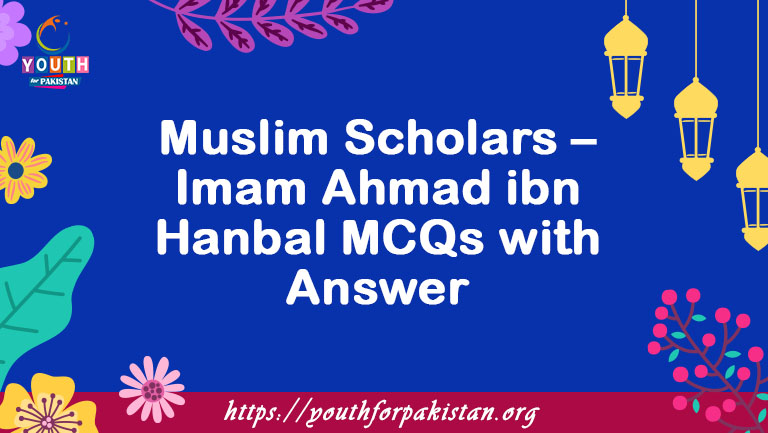The following are Muslim Scholars – Imam Ahmad ibn Hanbal MCQs with answers related to Islamic Studies. We have arranged the most important and repeated MCQs in all the competitive examinations. The students can clear their concepts for Muslim Scholars – Imam Ahmad ibn Hanbal MCQs online quiz by attempting these.
Muslim Scholars – Imam Ahmad ibn Hanbal Online MCQs with Answers
Who is Imam Ahmad ibn Hanbal?
A) A famous poet.
B) A renowned Islamic scholar.
C) A military commander.
D) A physician.
Imam Ahmad ibn Hanbal is known for his contributions to which Islamic science?
A) Astronomy.
B) Medicine.
C) Hadith.
D) Mathematics.
In which Islamic school of thought was Imam Ahmad ibn Hanbal a prominent figure?
A) Hanafi.
B) Maliki.
C) Shafi’i.
D) Hanbali.
What is the primary source of Islamic law followed by Imam Ahmad ibn Hanbal and the Hanbali school?
A) Ijma.
B) Qiyas.
C) Hadith.
D) Istihsan.
Imam Ahmad ibn Hanbal is best known for his compilation of which famous work?
A) Al-Muwatta.
B) Sahih al-Bukhari.
C) Sahih Muslim.
D) Musnad Ahmad.
Which Islamic legal principle is emphasized by Imam Ahmad ibn Hanbal?
A) Ijma.
B) Qiyas.
C) Taqlid.
D) Strict adherence to hadith.
What was the main focus of Imam Ahmad ibn Hanbal’s scholarly works?
A) Quranic interpretation.
B) Jurisprudence (Fiqh).
C) Islamic mysticism (Sufism).
D) Medicine.
Imam Ahmad ibn Hanbal lived during which century of the Islamic calendar?
A) 2nd century AH.
B) 3rd century AH.
C) 4th century AH.
D) 5th century AH.
What was Imam Ahmad ibn Hanbal’s stance on issues related to Islamic theology (Aqidah)?
A) He was an advocate of theological rationalism.
B) He strictly adhered to Athari creed.
C) He followed the Mu’tazili school of thought.
D) He was indifferent to matters of theology.
Which Caliph’s persecution of Imam Ahmad ibn Hanbal is well-known in Islamic history?
A) Caliph Al-Mansur.
B) Caliph Al-Ma’mun.
C) Caliph Al-Rashid.
D) Caliph Al-Amin.
How did Imam Ahmad ibn Hanbal’s opposition to Mu’tazilism impact his life?
A) He became a prominent Mu’tazili scholar.
B) He faced persecution and imprisonment.
C) He wrote extensively in support of Mu’tazili beliefs.
D) He was appointed as a judge by the Caliph.
What did Imam Ahmad ibn Hanbal famously say when asked about the Quran?
A) “It is created.”
B) “It is the eternal speech of Allah.”
C) “It is subject to interpretation.”
D) “It is the product of human effort.”
Which of the following is one of the key principles of the Hanbali school of jurisprudence established by Imam Ahmad ibn Hanbal?
A) Emphasis on consensus (Ijma).
B) Reliance on analogy (Qiyas).
C) Strict adherence to the Quran alone.
D) Strict adherence to the Hadith and the practice of the Salaf.
Imam Ahmad ibn Hanbal is known for his uncompromising stance against which theological doctrine?
A) Ash’ari theology.
B) Mu’tazili theology.
C) Athari theology.
D) Hanafi theology.
What is the name of the famous collection of Hadith compiled by Imam Ahmad ibn Hanbal, which is considered one of the most comprehensive Hadith collections?
A) Sahih al-Bukhari.
B) Sahih Muslim.
C) Musnad Ahmad.
D) Al-Muwatta.
In addition to his scholarly contributions, Imam Ahmad ibn Hanbal is also recognized for his:
A) Achievements in astronomy.
B) Poetry.
C) Military leadership.
D) Philanthropic work.
Which Islamic school of thought is closest in its beliefs and practices to the Hanbali school founded by Imam Ahmad ibn Hanbal?
A) Hanafi.
B) Maliki.
C) Shafi’i.
D) Salafi.
Imam Ahmad ibn Hanbal’s emphasis on Hadith and the practice of the Salaf reflects his commitment to:
A) Sufism.
B) Mysticism.
C) Traditionalism.
D) Rationalism.
Which famous Islamic university did Imam Ahmad ibn Hanbal teach at and where his teachings had a significant impact on his students?
A) Al-Azhar University, Egypt.
B) Al-Qarawiyyin University, Morocco.
C) University of Baghdad, Iraq.
D) University of Madinah, Saudi Arabia.
What was the famous legal case that Imam Ahmad ibn Hanbal was involved in during the Caliphate of Al-Ma’mun?
A) The case of the stolen treasure.
B) The case of a disputed marriage contract.
C) The case of the Quran being created.
D) The case of a political conspiracy.
Imam Ahmad ibn Hanbal’s uncompromising stance on theological matters earned him the title of:
A) Al-Mu’tazil.
B) Theological Reformer.
C) The Lion of Sunnah.
D) The Rationalist Scholar.
What was the outcome of the famous trial of Imam Ahmad ibn Hanbal during the Caliphate of Al-Ma’mun?
A) He was imprisoned and later executed.
B) He was declared a heretic.
C) He was exiled from the Islamic empire.
D) He was acquitted, and his stance was vindicated.
Imam Ahmad ibn Hanbal’s teachings continue to influence which group of Muslims who closely follow the Quran and Hadith?
A) Sufis.
B) Salafis.
C) Mu’tazilis.
D) Ash’aris.
What was Imam Ahmad ibn Hanbal’s view on the createdness of the Quran?
A) He believed the Quran was created.
B) He believed the Quran was eternal.
C) He did not take a stance on this matter.
D) He believed the Quran had a human author.
In addition to his scholarship, Imam Ahmad ibn Hanbal is also known for his:
A) Poetry.
B) Caliphal reign.
C) Medical expertise.
D) Architectural achievements.
Imam Ahmad ibn Hanbal’s staunch adherence to the Sunnah and Hadith led to his recognition as a champion of:
A) Tradition and orthodoxy.
B) Innovation and progress.
C) Mystical experiences.
D) Liberal interpretation of Islamic law.
Which of the following is NOT one of the key principles of the Hanbali school of jurisprudence established by Imam Ahmad ibn Hanbal?
A) Ijma.
B) Qiyas.
C) Istihsan.
D) Strict adherence to the Quran and Hadith.
Imam Ahmad ibn Hanbal’s teachings and scholarship have had a lasting impact on:
A) The development of Islamic art.
B) Islamic jurisprudence and theology.
C) The field of mathematics.
D) European Renaissance.
What is the name of Imam Ahmad ibn Hanbal’s famous collection of legal opinions (fatwas)?
A) Sahih al-Bukhari.
B) Sahih Muslim.
C) Musnad Ahmad.
D) Al-Muwatta.
Which Islamic empire saw the flourishing of Imam Ahmad ibn Hanbal’s teachings and the Hanbali school of thought?
A) Umayyad Caliphate.
B) Ottoman Empire.
C) Abbasid Caliphate.
D) Mughal Empire.
Imam Ahmad ibn Hanbal’s steadfast adherence to the Quran and Hadith is in line with the broader Islamic concept of:
A) Taqlid.
B) Ijma.
C) Sunnah.
D) Qiyas.
What is the name of the theological doctrine that Imam Ahmad ibn Hanbal firmly opposed, leading to his persecution?
A) Athari theology.
B) Mu’tazili theology.
C) Ash’ari theology.
D) Hanafi theology.
Which Islamic scholar is considered the “Father of Hanbali Jurisprudence” and laid the foundations for the Hanbali school of thought, which Imam Ahmad ibn Hanbal later developed?
A) Imam Abu Hanifa.
B) Imam Malik.
C) Imam al-Shafi’i.
D) Imam Al-Hasan al-Basri.
What is the primary source of Islamic law followed by Imam Ahmad ibn Hanbal and the Hanbali school?
A) Ijma.
B) Qiyas.
C) Hadith.
D) Istihsan.
Imam Ahmad ibn Hanbal’s teachings and scholarship continue to influence contemporary:
A) Philosophy.
B) Literature.
C) Islamic finance.
D) Islamic jurisprudence.
In which city did Imam Ahmad ibn Hanbal spend most of his life and establish his scholarly reputation?
A) Cairo, Egypt.
B) Medina, Saudi Arabia.
C) Baghdad, Iraq.
D) Damascus, Syria.
Imam Ahmad ibn Hanbal’s unwavering commitment to the Quran and Hadith made him a leading figure in the movement to preserve:
A) Islamic art.
B) Islamic heritage.
C) Islamic mysticism.
D) Islamic architecture.
What is the name of the religious doctrine that Imam Ahmad ibn Hanbal is associated with, emphasizing the strict adherence to the Quran and Hadith?
A) Taqlid.
B) Sunnah.
C) Fiqh.
D) Ijma.
Which Islamic scholar played a significant role in transmitting Imam Ahmad ibn Hanbal’s teachings to later generations and compiling his legal opinions?
A) Imam al-Shafi’i.
B) Ibn Taymiyyah.
C) Ibn Qudamah.
D) Imam Abu Hanifa.
Imam Ahmad ibn Hanbal’s uncompromising stance on theological matters contributed to the preservation of orthodox Islamic beliefs and practices, earning him the title of:
A) Theological Reformer.
B) The Rationalist Scholar.
C) The Defender of Sunnah.
D) The Mystic Philosopher.
Which Islamic legal principle is emphasized by Imam Ahmad ibn Hanbal?
A) Ijma.
B) Qiyas.
C) Taqlid.
D) Strict adherence to hadith.
Imam Ahmad ibn Hanbal’s teachings and contributions to Islamic jurisprudence continue to serve as a source of guidance for:
A) Contemporary artists.
B) Medical researchers.
C) Modern philosophers.
D) Islamic scholars.
What is the name of the religious doctrine that Imam Ahmad ibn Hanbal is associated with, emphasizing the strict adherence to the Quran and Hadith?
A) Taqlid.
B) Sunnah.
C) Fiqh.
D) Ijma.
Imam Ahmad ibn Hanbal’s steadfast adherence to the Quran and Hadith is in line with the broader Islamic concept of:
A) Taqlid.
B) Ijma.
C) Sunnah.
D) Qiyas.
In addition to his scholarship, Imam Ahmad ibn Hanbal is also known for his:
A) Poetry.
B) Caliphal reign.
C) Medical expertise.
D) Architectural achievements.
What was the famous legal case that Imam Ahmad ibn Hanbal was involved in during the Caliphate of Al-Ma’mun?
A) The case of the stolen treasure.
B) The case of a disputed marriage contract.
C) The case of the Quran being created.
D) The case of a political conspiracy.
Which Islamic school of thought is closest in its beliefs and practices to the Hanbali school founded by Imam Ahmad ibn Hanbal?
A) Hanafi.
B) Maliki.
C) Shafi’i.
D) Salafi.
What is the primary source of Islamic law followed by Imam Ahmad ibn Hanbal and the Hanbali school?
A) Ijma.
B) Qiyas.
C) Hadith.
D) Istihsan.
Imam Ahmad ibn Hanbal’s teachings and scholarship have had a lasting impact on:
A) The development of Islamic art.
B) Islamic jurisprudence and theology.
C) The field of mathematics.
D) European Renaissance.
In addition to his scholarship, Imam Ahmad ibn Hanbal is also known for his:
A) Poetry.
B) Caliphal reign.
C) Medical expertise.
D) Architectural achievements.










